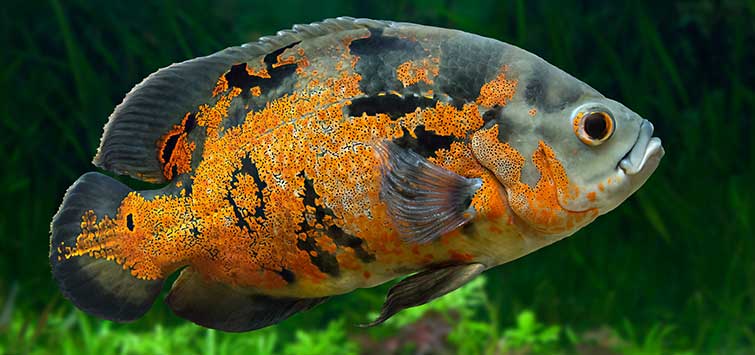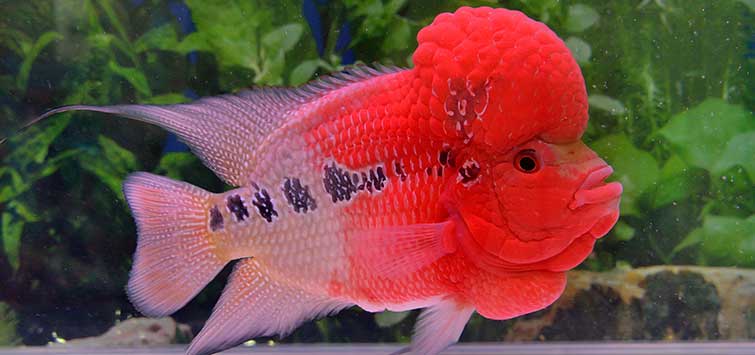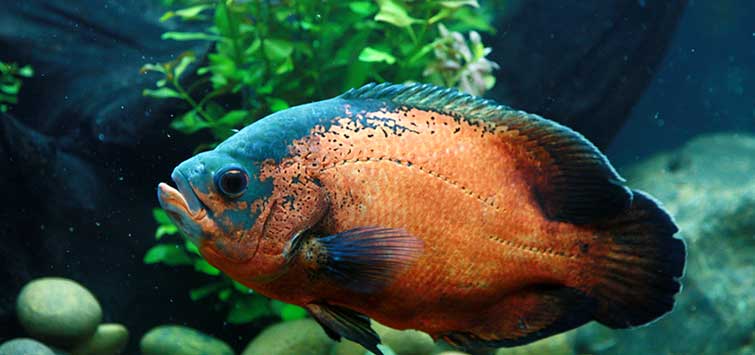Astronotus sp..
Common Names: Oscar
Type Locality: Atlantic Ocean, erroneously
Range: Amazon basin in Peru, Colombia, and Brazil, also in French Guiana. Firmly established as an alien invader in Florida, where it is enjoyed as a game fish, popular both for its fighting spirit and for its excellent flavor.
Taxonomic Troubles: Originally described as Lobotes ocellatus Aggaziz 1831. Currently there are two or three recognized species: A. ocellatus, A. crassipinnis, (A. orbiculatus). These fishes are highly variable across a large range, so more species may be forthcoming. Al
Size: 40 to 46 cm (15 to 18 in) TL, 1.6 kg (3.5 pounds) in weight.
Preferred Water Chemistry: Tropical freshwater, otherwise undemanding.
Difficulty: Very hardy and long-lived when properly maintained.
Tank Setup: The oscar tank must be well covered, large, and well filtered. Frequent large water changes are necessary to prevent HLLE. Figure a minimum of 20-50 gallons of tankspace per oscar. If given gravel--problematic for maintaining these messy, heavy feeders
Feeding: Largely carnivorous, but as much of the diet is small invertebrates, a lot of vegetable matter is consumed in the guts of prey items. The worst food is feeder fish, which have killed and maimed many a pet oscar through disease and dietary deficiency.
Breeding: Of moderate difficulty. ALthough experts can vent sex these fish, the sexes are otherwise indistinguishable. Best results are obtained in any case with pairs that form naturally. They breed in typical substrate-spawning cichlid fashion, with large spawns, and are excellent parents. Obviously, a large aquarium is necessary. Pairs are usually stable and reliable spawners, especially compared to other cichlids, but as with many cichlids, things happen.
Fish Description
A soft, velvety brown with light mottling and iridescent red or orange markings; often with one or more prominent black and red ocelli, especially on the caudal peduncle. A great many domesticated forms have ben developed, including albino and long finned.
Notes
Extremely popular both as a food fish in the Amazon and as an aquarium specimen, the oscar may also be one of the most inappropriate fish for most people who buy them. The wriggly cute juveniles grow into personable and interactive--even affectionate--pets. Perhaps the oscar should be the poster child for mishandled aquarium species. A typical scenario is for a tiny oscar to be added to a 10-gallon community tank. It quickly puts on size and swallows all its tankmates, then it outgrows the tank. At this point, the lucky few have owners who belatedly learn about the fish and provide a proper tank setup. Some become "proof" of the myth that large species will only grow as large as their tank; they languish, stunted by malnutrition and ammonia poisoning, until they die. Given enough clean water--through large, frequent water changes in big tanks--these fish thrive in captivity and live for many years. Fortunately, there are many oscar-loving aquarists who enjoy the companionship of these beautiful animals and display them in sufficiently large tanks. They are excellent for giant community tanks with large cyprinids or characins. In truly monstrous multi-thousand-gallon aquaria, they will school, making an awesome display.

.png?h=595&iar=0&w=2781&hash=5FD5E69473BCC22199FBFA2FB71B6033)



